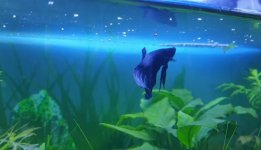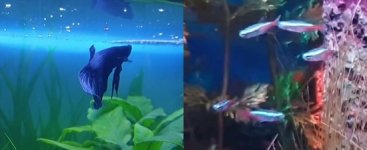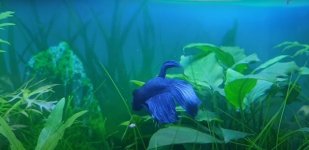Betta Fish Care Guide, Breeding, Tank Size, Temperature & Water Quality, & More:
If you want to take good care of betta fish, then find ways to make them healthy & happy. Avoid activities that put your betta fish in stress. In this article we are going to discuss everything required to make betta fit & active. A lot of people put betta in fish bowls, or vase which does not mean they don’t need large space for swimming. Such bettas are in extreme stress because they also need a big aquarium, with clean water (aquarium filter), decorations & live plants. Also make sure you have right temperature for your betta & you are feeding them healthy food.If you are successful in providing the best environment for them, then your fish may survive up to 10 years. Bettas are gorgeous & genius fish, & needs quality life.

How to identify whether your betta is healthy or sick?
Make sure you watch betta carefully at stores before purchasing them. Check out how they swim, do they have bright or dull colors, or whether they have fine or damaged fins? Etc. Below you can find all instructions about choosing which betta to buy from pet stores?- A healthy betta has following features:
- A healthy betta swims up to examine when someone get closer to their home
- Healthy betta is aggressive & may flare at you or other stimuli
- They have bright colors, & especially male betta show brighter colors than females
- A healthy betta is hungry & eat regularly
- Their fins are not damaged
Diseased betta:
- Diseased betta shows loss of appetite for quite a long periods of time
- Inactive, shy & hide frequently
- Their colors are dull, especially in male betta
- Their fins are damaged
- You may find white growths on mouth or body of betta
- They swim abnormally
- Difficulty in breathing
- Bloated
Betta Fish Aquarium Size & Environment:

Betta Tank Size
- Betta needs an aquarium which contains 5 gallons of water, but at least your aquarium should have 2.5 gallons of water
- Small aquariums are worse, needing high maintenance
- Do not put bettas in bowls or vases
- Betta fish can jump out of aquarium so make sure you cover the top of aquarium using a lid
- Make sure you have free space at surface of water or do not fill up your aquarium to its max. capacity
- You can put females in a union of 5 or more in a single aquarium
- Use an aquarium divider to make room for 2 bettas in one aquarium
- Bettas require natural or artificial light so that they are awake during day time, & when its night, they can sleep
- Live plants or decorations can provide shade so that betta can avoid aquarium lighting
- Avoid direct sunlight from entering aquarium because it can quickly increase temperature of water to higher levels & help algae growth
- Make sure you use artificial lighting for betta
Below you can watch a video which shows how to setup aquarium for betta:
Betta Aquarium Setup
Betta Fish Breeding:
Do not mix up 2 males, or a male & female in one aquarium unless breeding. For breeding purpose, keep both male & female together for a shorter period, & then separate them. Bettas are aggressive & they try to hurt each other which might cause death or one of the fish might be severely stressed.
Females can live in union of 5 or more but needs large aquarium. Make sure you follow a good rule of thumb of having 1 gallon of water per 1 inch of each fish. For example, having 6 females, each 2 inches need 12 gallons of aquarium.
During breeding period, when betta fish become highly exalted, they show brighter colors that appears to be more saturated & this is the way to recognize female beta of their purpose.

Betta Tank Mates:
Some betta types are very aggressive & they don’t want to share same aquarium with mates, but others are happy to live with other species that are not aggressive & do not have bright colors or long fins.
You can keep mates with betta if you have larger aquariums with many hiding spots. It is advised to have a tank that can hold 8 or more gallons of water to offer a number of hiding places for your betta.
More space in big aquariums will reduce the territorial instincts of the fish & may lower its aggression against certain kind of species.
Do not put 2 male bettas in one aquarium because they will fight till death or unless one of them is very stressed. This is a gruesome process & should be avoided. Do not put a male with a female unless they are breeding. Use a divider to isolate 2 bettas.

Ideal Water Temperature for Betta
- Ideal water temperature for betta is 76 – 81 degrees Fahrenheit
- Bettas like to live in water in pH range of 6.5 to 7.5
- Add de-chlorinated water to aquarium
- Monitor temperature of water using a thermometer
- Use filter to control levels of toxic components
- Avoid quick changes in temperature of water because it can put your betta in stress. Also quick increase in water can help algae growth.
Bettas come from a tropical climate of Thailand so they love to live in warmer water in aquariums. Make sure aquarium water does not drop below 65 degrees or rise over 82 degrees, but try to maintain them in an ideal temperature range of 76 to 81 degrees Fahrenheit. In this temperature, bettas are very active.
Aquarium Filter For Betta:
Make sure you have a running filter in aquarium to minimize the risk of losing betta or putting it in stress. They decrease level of toxic bacteria & help in growth of beneficial bacteria. Filters are cheap & required for aquariums.Betta do not swim too much & filters can put them in stress if it releases strong current of water. Putting betta in such tank for prolonged period of time can lead to ripped fins, stress, & could be the reason behind their death. Make sure your filter is adjustable or recommended for betta fish.
Aquariums that can hold under 3 gallons of water will require more frequent & full water changes so that high buildup of ammonia can be wiped out. However, tanks greater than 3 gallons require cleaning based on its size & also how much water to be changed is based on how much water it can hold.
Aquariums with no filter need 1-2 water cycles of 25 percent of full volume & a complete water change every week based on quality of water. If your aquarium can hold 5 gallons of water, then it will only require 1-2 water cycles in a week of 25 percent & a full water change once in a month based on quality of water.
Make sure you fill your tank with de-chlorinated water & temperature of water adding to aquarium is the same as that of aquarium water.

Feeding Betta
- Bettas are carnivores & they eat protein rich diet.
- Do not cover surface of water, because they eat from surface
- They love food of their choice & may like a different treat
- When you overfeed betta, it causes health problems
- Feed only 2-4 pellets to betta, 1 to 2 times a day
- Betta loves a variety of foods
Betta are carnivores & they love to eat meat. They eat insects & their larvae on the surface of water. A variety of diet will keep them satisfied & help them in growth.
They like eating pellets, flakes, live & freeze dried foods. The common diets include meat, fish, & shrimp. Feed them protein rich food.
If they refuse to eat food, then try a different brand because they are choosy eaters & would eat something of their choice. Hence keep on changing brand unless you find the right food for them.
